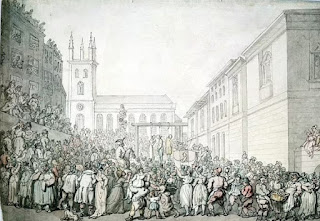Hanging
Hanging
Hanging as a means of capital punishment was mentioned in Homer's Odyssey, but became a common method of execution by the Middle Ages. In the US, it remained the primary means until the 1890s - and still today the practice is mostly unchanged where it is legal in countries including Japan and Singapore.
Prisoners sentenced to be hanged are often weighed before the execution and rehearsals performed to work out how much 'drop' will be needed to kill them quickly. Too much rope can lead to decapitation after the condemned person falls through the air, and too little can result in strangulation lasting as long as 45 minutes.
The most recent recorded example of this was the execution of Barzan Ibrahim al-Tikriti, one of three half-brothers of Saddam Hussein. He was hanged on January 15, 2007 for crimes against humanity (along with Hussein) - but was decapitated by the rope due to a mistaken calculation about his weight and the length of the drop.
Before an execution by hanging, a prisoner's limbs are secured, they are blindfolded and a noose is placed around the neck. In traditional executions, a trap door falls open for the prisoner to drop through. Their weight should cause a rapid fracture-dislocation of the neck - but it is rare the prisoner dies immediately.
Isan still uses cranes to hang its prisoners, tying them to a noose and then lifting them high in the air to be seen for miles. In 2022, protestor Majidreza Rahnavard made headlines when he was charged with 'waging war against God', ran through a 'sham trial' and put to death.
Executions conducted in public with a crane have been more rare in recent years, though Iran used the same manner of hanging to put down unrest following the disputed 2009 presidential election and the Green Movement protests that followed.
Typically, those condemned are alive as the crane lifts them off their feet, hanging by a rope and struggling to breathe before they asphyxiate or their neck breaks.
Public hangings are nothing new. In England in the 1800s, events could attract thousands, or tens of thousands, of viewers with a perverse fascination in watching the brutal death. In a scathing criticism of capital punishment, French philosopher Albert Camus noted that the spectacle of brutal killings did not seem to deter criminals; hangings often attracted as many pickpockets, drawn to the large crowds of people. Of 167 condemned inmates at Bristol prison in 1886, 164 had themselves watched the horrific means of execution already.
Still, it took more horror stories before Britain abolished the penalty formally in 1998. In 1953, British man Derek Bentley was hanged for the murder of a policeman during a burglary attempt. Aged 19, the man was hanged at Wandsworth Prison. The case provoked debates Bentley was later pardoned and proven innocent. The complexities of the case, including views on Bentley's learning difficulties, created public outrage at the time.
Even today, with advances in forensic evidence gathering and justice, for every eight people executed, one person on death row has been exonerated - leaving countless potentially wrongfully sent to their deaths.






Comments
Post a Comment